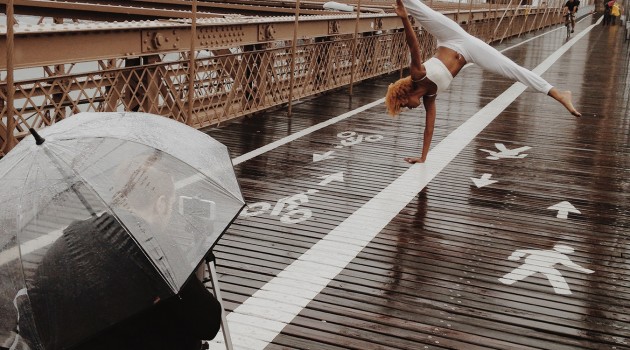THE IPHONE’S SLO-MO VIDEO HAS BECOME A DANCER’S BEST FRIEND
iPhone 6’s slow motion superpowers to capture waves crashing on the beach, bicycle wheels spinning by in a race, and to turn a dog’s adorable yaps into a ferocious 240 fps growl. But plenty of people have started using slow motion to more practical ends. Including dancers.
Before the advent of high-quality smartphone shooters, slow-motion was largely left to movie montages, pro-sports instant replays, or pricey camera rigs. The idea that dancers, particularly freelancers and students, would have access to that sort of technology was unthinkable. When you’re making under $30k a year, that money is going towards food and rent, not a high-end DSLR. But now that a smartphone has become practically standard issue, previously high-end camera technology is accessible to almost everyone. And slow motion, while initially more of a gimmick, has slowly matured into a mainstay for some people.
For dancers, it’s become an incredibly useful tool for honing their craft. The newfound affordability of slow motion has enabled them to improve their technique, spruce up their audition reel, and isolate aspects of their performance that were once intangible.
“If my students can’t understand the momentum of a certain movement, slo-mo makes it a really simple thing to break it down,” freelance dancer and dance instructor Ashley Marinelli told WIRED. She uses slo-mo as a teaching tool in dance classes in the Tri-State area, showing, for example, how to properly fall into and rise from the ground smoothly and cleanly, without injury, during contemporary classes. She’s been using video as a teaching aide for about two years, capturing rehearsals with either her iPhone 5 or iPad mini. When the situation calls for slow motion, she uses the Slow-Pro app on her iPhone 5, or uses a borrowed iPhone 6 (“The technology on the iPhone 6 is far superior, so I mooch off of my generous friends whenever I can,” Marinelli explained).
Video has been an important part of documenting dance rehearsals, performances, and audition materials for years, but only recently has it begun creeping into dance classes. Say you’re demonstrating a complicated jump for students. Once you leave the ground, you’re falling back down at 9.8 meters per second squared, whether you like it or not. There’s only so much you can demonstrate step-by-step, unless you awkwardly suspend yourself in mid-air propped against the barre at the back of the room. With a smartphone, you can capture that movement and replay it to explain exactly what happens moment to moment. It saves precious class time, and eliminates ambiguity.
Lindsey Miller, a dancer with Alison Cook Beatty Dance company, owns an iPhone 5c, but has worked with director and photographer Tristan Pope to record herself with an iPhone 6. This allows her to see how her muscles move, and improve skills on her own, helpful when there’s no instructor around to offer critiques. Being able to see the breakdown of motion that happens in a split second provides insight on the physics of what exactly occurs when she dances, she says.
Pope, meanwhile, is an avid user of slo-mo. He exclusively used the iPhone 6’s 240 fps slo-mo in a short film called Dancers of New York, which has been selected as a contestant in the International Mobil Film Festival. In the video, you see daring leaps, high kicks, and acrobatics slowed down such that you can watch legs stretch and muscles contract with impressive detail. It’s mesmerizing. Pope embarked on the project mere hours after buying the latest iPhone last fall, shooting the first dancer for Dancers of New York, Anna Pinault. The results were instantly impressive.
“When I hit record and she did her dance move, I remember thinking ‘Well, that was cool,’” Pope said. The two huddled over the phone to check out the results. Not only could they see a stunning move from prep to finish, they could discern where it needed to be improved upon and repositioned to ensure the next shot was perfect, both in terms of technical execution, and camera angles and lighting. On average it took only ten minutes to get the right shot from each dancer, after a 15 to 30 minute set up.
Pope said the only issue he ran into with slo-mo for his particular project shooting in low light conditions. When you increase the frame rate per second, you need a higher digital ISO to counteract the lower exposure time each frame is getting. The iPhone can’t compensate for that quite yet. While the footage Pope took at night was still viewable, it was too grainy to include in his piece. “240 fps just eats your light,” Pope wrote in a blog post about the project. He just recently finished another short piece that features a dancer in the snow.
There’s also more to a dance performance than just body movements. And as Marinelli discovered, slow motion footage can also reveal the almost imperceptible changes in expression that can make the difference between landing a gig and falling flat.
“I was doing one movement, over and over, and I realized you can see where enjoyment starts in your face,” Marinelli recalled, explaining how her smartphone picked up even the smallest shifts in expression. “You can see the mental processing of ‘Oh my god I hope this works out, oh my god it’s going to work, oh it’s fun I’m flying, oh I hope I land okay. Facial expressions that take a millisecond in real time.”
Capturing these seemingly tiny nuances can set a dancer apart from his or her competition when auditioning for a role, highlighting details of artistry and technique that otherwise might be glanced over. Dancers have been augmenting their resumes with video footage for years (many companies require video as part of the audition process, particularly if they can’t be there in person). The addition of slo-mo to a video reel also adds an “extra bit of movie magic finesse,” according to Pope, who finds himself behind the casting table in addition to behind the camera. It certainly doesn’t hurt for your video to look more pro.
Of course, not all dancers can, or will, take advantage of slo-mo. Some companies, like San Francisco Ballet, do not permit any sort of smartphone recording during class or rehearsal due to union rules. But for freelancers like Miller, Marinelli, and others, it’s become a unique creative tool to add to their portfolio, and a way to shine light onto technical faux pas that even the most eagle-eyed instructors might otherwise miss.





